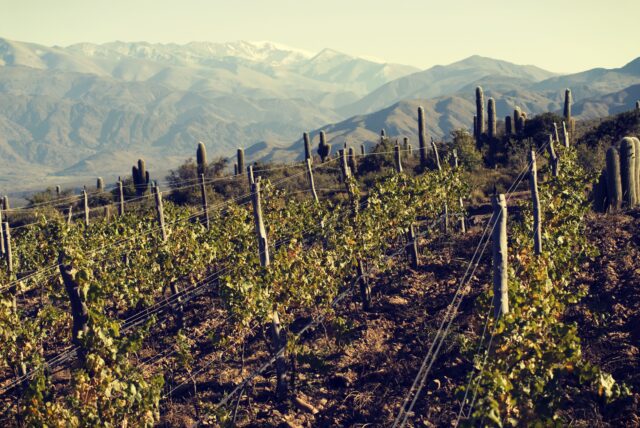Once deemed witchcraft, dowsing locates underground water sources via a guiding instrument, such as a willow branch, metal rods or pendulum.
By L.M. Archer
As climate change intensifies, many vineyards are turning to high-tech tools for water scarcity solutions. But a few rely on an old-school method to solve their water issues. Sometimes known as water divining, dowsing or water doodling, this ancient art draws its share of doubters. However, for vineyard owners in water-poor wine regions, dowsers can be the difference between life and death.
Water in Washington
“We’ve used a dowser for every well on the family property,” says Jeff Andrews of Andrews Family Vineyards and Trothe Wines in Prosser, Wash. In 1956, Andrews’ grandfather employed a dowser to locate the land’s first well site. That well transformed the Andrew’s family farm from a dusty sagebrush desert into a thriving wheat, food crop and cattle concern.
Eventually, grapes replaced cattle. Today, Andrews and his family cultivate 1,300 acres of winegrapes in the Horse Heaven Hills AVA. “My grandad used to say he wasn’t sure if he believed in well witching, but he’d never drill a well without it,” says the fourth-generation farmer.

California Dreaming
In California, which has experienced a spate of dramatic droughts and wildfires, water has become more than just crop nourishment. Meanwhile, dwindling water supplies have led to an increase in governmental oversight of water use and well drilling.
“It’s cheaper to buy water from the government, by far, than it is to pump it out of the ground, particularly with our rates going up like they are these days,” says vineyard owner, winemaker and dowser Marc Mondavi. “They’re clamping down on water, and farmers are forced to either go out of business or drill some wells so that they have water to grow their crops.”
![Marc Mondavi dowsing for water [courtesy Marc Mondavi]](https://wineindustryadvisor.com/wp-content/uploads/2022/08/MarcMondavi_Image-by-Marc-Mondavi-Water-Divining-Media-Images-300x450.jpg)
Part of Napa’s famed wine family, Mondavi discovered his own dowsing skills at age 17 when the father of a girlfriend “took me up to the vineyard and said, ‘Let’s see if you can do it.’ That’s when I found out.”
The mysterious process of dowsing uses a variety of instruments that “react” to the presence of underground waterways, metal ore or other hidden treasures (depending on what you’re looking for). Mondavi, who dowses for water worldwide, says, “The feeling is indescribable. I know the rods will move before they move. I can’t explain how I know. It’s a sensation.”
Although never proven scientifically, dowsing remains a fairly common tool for farmers across the globe. Mondavi says he’s seeing an uptick in the practice in California. “People are definitely digging more wells these days,” he says. “Drought is impacting most farmers. I wouldn’t say all farmers, but most farmers [I know] will use dowsers before they drill a well.”
The Legend of El Loco
Dowsers play a prominent part in the viability of international vineyard projects. In 1999, Swiss businessman and winery owner Donald Hess of The Hess Collection purchased a vineyard high in the Calchaqui Valleys of Argentina. The prior owner had unsuccessfully attempted to plant vines for 60 years in the unforgiving, arid, high-altitude area.
Despite these dire warning, Hess — a gifted dowser — walked the land, using a pendulum, to find water. After locating a spot, he drove three hours to the nearest town of Salta to hire a well driller. Hess stayed with the drillers for six consecutive days and nights. On the sixth day, the crew struck water at 656 feet. Hess christened the vineyard El Arenal, Spanish for “sandy.” Locals dubbed Hess “El Loco.”

Rather than plant vineyards first, Hess instead built housing with potable water for all of the indigenous families living around El Arenal. “Normally, when someone buys a company, they grow it in order to get back the investment,” says Javier Grané, vineyard manager at Bodega Colomé, one of The Hess Collection’s four Argentinian projects. “Donald changed everything. He brought water to the people between 2001 and 2003. He made a better life for the people first. Then he started on the vineyards.”
Ultimately, Hess’s dowsing skills impacted not just his vineyards and community, but the region itself. “Because Donald found water here and was very successful with his wine, now other people are interested in buying land and plan on making other vineyards.” Presently, the Calchaquí Valleys contain more than 10,378 acres of vines.
Ask the right questions
Eventually, Hess passed along his dowsing knowledge to Grané.
Asked how he thinks the process works, the vineyard manager says, “When we talk about dowsing, we refer to different magnetic exchanges that occur between different objects.” This means the proper choice of antenna, or indicator element, is vital. Common options include pendulums, plant rods (such as willow branches) and metal rods. Each varies in sensitivity, or amplification of magnetic signals received.
![Divining rods used by Javier Grané [courtesy Javier Grané]](https://wineindustryadvisor.com/wp-content/uploads/2022/08/Javier-Grané-divining-rods_Image-courtesy-Javier-Grané-e1660322056500-300x169.jpeg)
Grané’s personal technique includes four basic steps:
- Sensitize the body: “It must be clean and rested, in good health — without breakdowns or pain — with loose and very comfortable clothes. I avoid footwear with rubber soles, because they are insulating. The body must be connected to the earth as much as possible. It would be best without shoes.”
- Clarify the mind: “I must be free of tensions and worries, be relaxed. Then I concentrate to visualize the target as sharply and constantly as possible.”
- Ask correctly: “When concentrating on our goal, we must ask in a brief and very clear way, so that the only possible answers are YES or NO. Many times, what we want to know must be asked in parts and in different ways, before reaching an accurate conclusion. All these skills we can develop with training, like any language.”
- Bronze rods: “They act as an amplifier while facilitating the reading of answers. The rods are held parallel in each hand, and respond by YES when they close and cross each other, or NO when they open in opposite directions.”
Grané, who’s located nine wells to-date, remembers, “Many years ago, [Hess] told me, ‘Anyone can do this. It’s just training, concentration and a clean mind.’”
_______________________________________________________________________

L.M. Archer
L.M. Archer is an award-winning writer and content provider for consumer, B2B and B2C platforms and publications worldwide, including Somm TV Magazine and Wine Business Monthly. Find her at www.lmarcher.com + IG/Twitter @lmarcherml

















My uncle who was a plumber taught me how to divine for water using brass rods. He also showed me how to determine the depth to water and depth of water column. I pit it to use in 1985 up on my property located on Spyrock Rd. in Laytonville, CA. My property was located on top of a mountain and only had a higher peak to the South about two miles away. After going back and forth with the rods i found a spot close to our cabin. The water was around 60 feet deep according to my rod made from a open coat hanger with a weight on the end. I called a drilling company and when the person arrived to drill, he just laughed at me, “There is no water here, I have a geology degree from UC Berkley.” I told him it’s my money, just drill. He did, but didn’t laugh when we hit water at 60 feet at around 10gpm. This well is still being used today by the new owner.
Since than i have taught engineers at the Santa Clara Valley Water District and used it to find existing water mains which all the reference monuments were lost and the only method was to pot hole.
“The Divining Hand” is the ultimate book on dowsing. The human body is the instrument (not the rods or branch) sensing the subtle information field that leads to finding water, metals, oil, etc.; this explains “map dowsing” from a distance using only a map and pendulum. Some dowsers don’t even need tools! Science has totally bypassed this area of information because it’s nonreplicable empirically; it relies on human intuition which can be hit or miss. However full-time, experienced dowsers can hit the well every time. Also read “Report on Radionics” by Edward Russell for another form of suppressed subtle energy that’s manipulable and is legal in the UK but outlawed in the US for medical use.